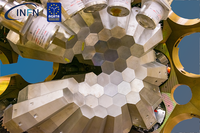Speaker
Description
Neutrinoless double beta (0νββ) decay is a hypothetical radioactive process that proves the Majorana fermion nature of neutrino. Recently, matrix elements were determined in 76Ge (parent) [1] and 76Se (daughter) [2] via Coulomb excitation experiment, enabling a model-independent analysis of the nature of deformation, which is important for calculations for the nuclear matrix elements relevant for 0νββ decay.
A new limit on the half-life of 0νββ decay in 150Nd has been reported by NEMO-3 Collaboration recently [3]. Parent 150Nd and daughter 150Sm are located at the shape transition region at N=88 to N=90 [4]. The 150Nd, 152Sm were proposed to have X(5) dynamical symmetry, which is the critical point between spherical vibrator and axially deformed rotor [5,6]. On the other hand, the proposed vibrational 150Sm has an anomalous sharp increase of kinematic moments of inertia, which exceeds the limit of rigid rotor at high spin. The 150Sm was also proposed to have enhanced octupole collectivity at medium spin [7]. The proper treatment of deformation, including the octupole degree of freedom, for 150Sm is essential for reliably calculating the NMEs for 0νββ decay. However, the precise measurement of deformation and matrix elements for 150Sm is lacking.
In this proposal, we aim to perform a model-independent comprehensive study of the quadrupole-octupole triaxial degree of freedom, based on measured E2 and E3 transition matrix elements in 150Sm via Coulomb excitation. We plan to use 210 MeV 58Ni beam from TANDEM bombarding 150Sm target. Based on preliminary estimates, with a beam intensity of 1.5 pnA, the beam time required is approximately 200 hours. The deexcitation γ rays will be detected by the AGATA tracking array in kinematic coincidence with scattered reaction products recorded with the SPIDER array. Then, the measured γ-ray intensities will be analyzed using the semiclassical, coupled-channel, Coulomb excitation least-squares search code, GOSIA, to determine the matrix elements. We have acquired proficiency in the ‘quadrupole sum-rules', enabling us to derive model-independent values for β2, γ, and β3. The results may directly impact the nuclear matrix elements relevant for neutrinoless double beta decay.

